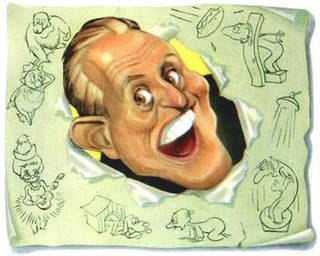The year 1962 involved some significant events in television. Below is a list of notable events of that year.
The year 1960 in television involved some significant events. Below is a list of television-related events during 1960.

Television news in the United States has evolved over many years. It has gone from a simple 10- to 15-minute format in the evenings, to a variety of programs and channels. Today, viewers can watch local, regional and national news programming, in many different ways, any time of the day.

The Arthur Murray Party is an American television variety show which ran from July 1950 until September 1960. The show was hosted by famous dancers Arthur and Kathryn Murray, and was basically one long advertisement for their chain of dance studios. Each week the couple performed a mystery dance, and the viewer who correctly identified the dance would receive two free lessons at a local studio.
The following is the 1963–64 network television schedule for the three major English language commercial broadcast networks in the United States. The schedule covers primetime hours from September 1963 through August 1964. The schedule is followed by a list per network of returning series, new series, and series cancelled after the 1962–63 season.

House Party is an American radio daytime variety/talk show that aired on CBS Radio and on ABC Radio from January 15, 1945 to October 13, 1967. The show had an equally long run on CBS Television as Art Linkletter's House Party and, in its final season, The Linkletter Show, airing from September 1, 1952 to September 5, 1969.

Daytime television is the general term for television programs produced for broadcast during the daytime hours on weekdays; programs broadcast in the daypart historically have been programmed to appeal to a female audience.
The following is the 1958–59 network television schedule for the four major English language commercial broadcast networks in the United States. The schedule covers primetime hours from September 1958 through March 1959. The schedule is followed by a list per network of returning series, new series, and series cancelled after the 1957–58 season.
The 2006–07 network television schedule for the six major English language commercial broadcast networks in the United States. The schedule covers prime time hours from September 2006 through August 2007. The schedule is followed by a list per network of returning series, new series, and series cancelled after the 2005–06 season.
The following is the 1951–52 network television schedule for the four major English language commercial broadcast networks in the United States. The schedule covers primetime hours from September 1951 through March 1952. The schedule is followed by a list per network of returning series, new series, and series cancelled after the 1950–51 season. This was the first television season of national network interconnection by coaxial cable and microwave, meaning programming could be transmitted live coast-to-coast if needed.
The 1948–49 network television schedule for the four major English language commercial broadcast networks in the United States. The schedule covers primetime hours from September 1948 through March 1949. The schedule is followed by a list per network of returning series, new series, and series cancelled after the 1947–48 season. This was the first season in which all four networks then in operation in the United States offered nightly prime time schedules Monday through Friday.
The 1947–48 United States network television schedule was nominally from September 1947 to March 1948, but scheduling ideas were still being worked out and did not follow modern standards. The schedule is followed by a list per network of returning series, new series, and series cancelled after the 1946–47 season.
Ford Theatre, spelled Ford Theater for the original radio version and known, in full, as The Ford Television Theatre for the TV version, is a radio and television anthology series broadcast in the United States in the 1940s and 1950s. At various times the television series appeared on all three major television networks, while the radio version was broadcast on two separate networks and on two separate coasts. Ford Theatre was named for its sponsor, the Ford Motor Company, which had an earlier success with its concert music series, The Ford Sunday Evening Hour (1934–42).
Celebrity Time is an American game and audience participation television series that was broadcast on ABC in 1949 - 1950 and on CBS in 1950 - 1952. The original host was Douglas Edwards.
Actors Studio is an American television series that was hosted by Marc Connelly. It originally aired on ABC from September 26, 1948 to October 26, 1949 and then on CBS from November 1, 1949, to June 23, 1950. It was one of the first series to be picked up by a network after being cancelled by another network.
Stop the Music is a prime time radio game show that aired on ABC Radio on Sundays, from March 21, 1948 to August 10, 1952. Stop the Music crossed over to ABC television on Thursdays, beginning on May 5, 1949 through April 24, 1952, and again for a half-hour from September 7, 1954, to June 14, 1956.
Star of the Family is a CBS Television program which premiered on September 22, 1950, and aired until June 26, 1952.
Club Seven is an early United States television series, which aired from 12 August 1948 to 1951 on ABC. Some episodes were 30 minutes, while others were 15 minutes.
Versatile Varieties, also known as Bonnie Maid Versatile Varieties and Bonny Maid Versatile Varieties, is a TV series that ran from 1949 to 1951 on NBC, CBS and ABC under three different formats. The sponsor was Bonnie Maid Linoleum.



